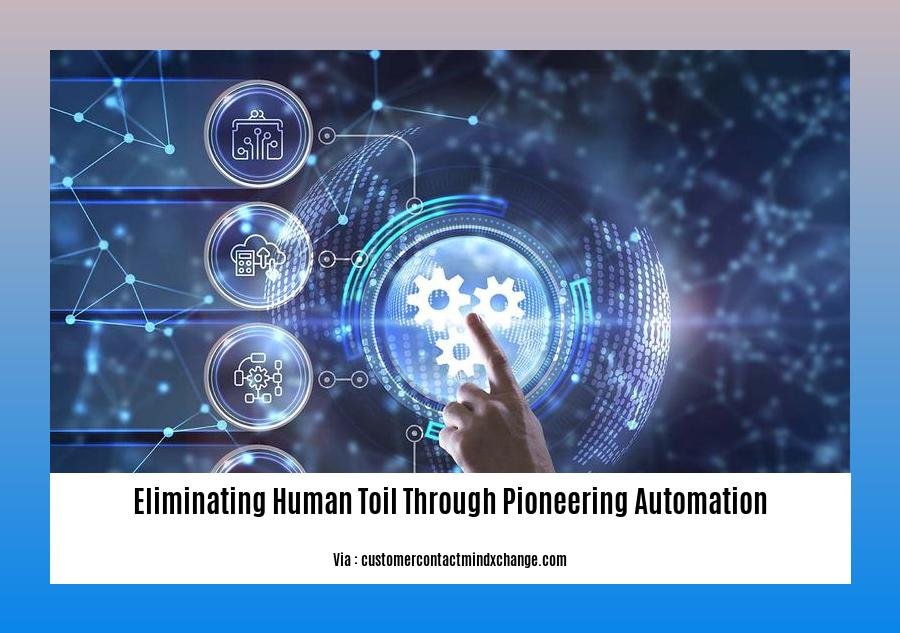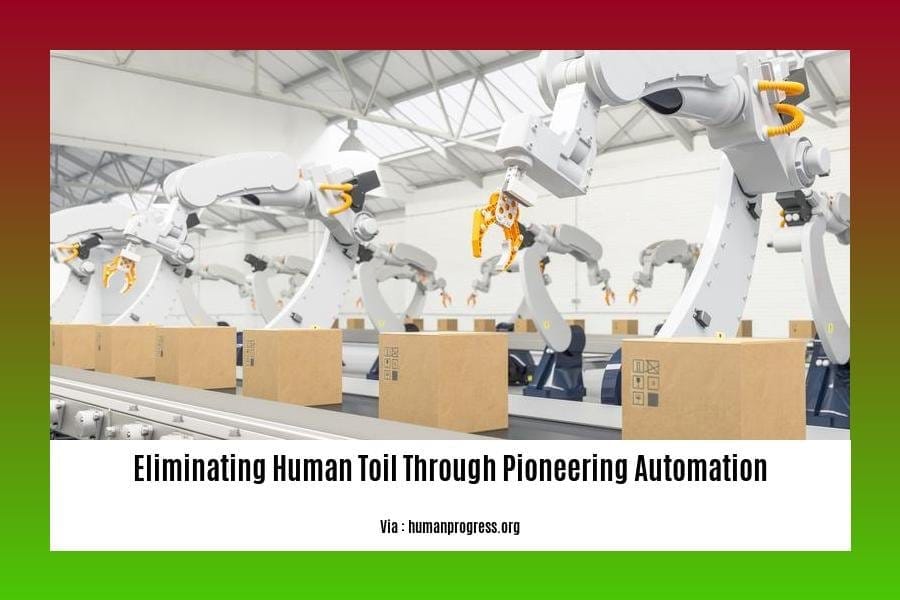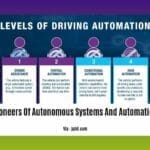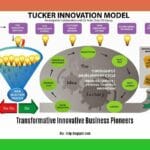Step into the realm of “Eliminating Human Toil Through Pioneering Automation: The Transformative Power of Technology.” As we venture deep into this technological revolution, let’s explore the groundbreaking advancements that are reshaping industries and redefining the future of work.
Key Takeaways:
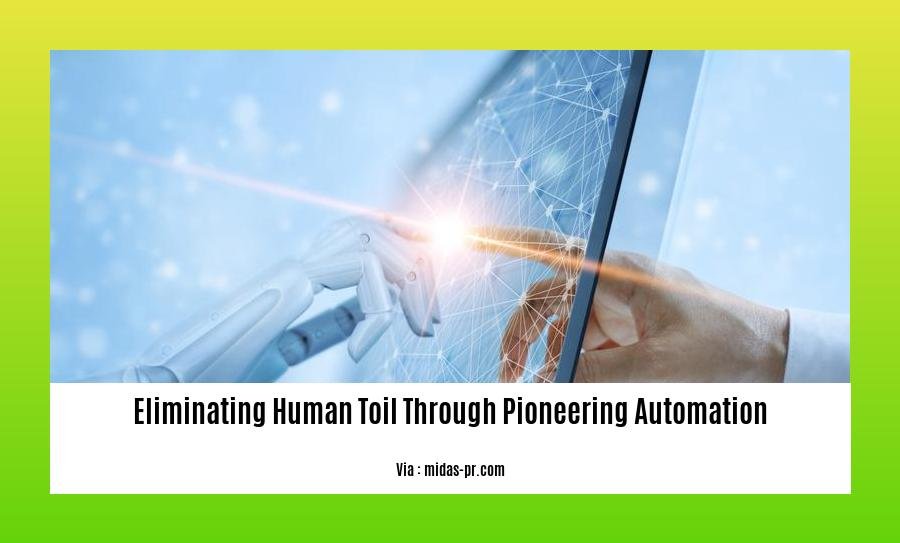
- Toil: Repetitive, manual tasks that hinder productivity.
- Automation: A key strategy to minimize toil by automating automatable tasks.
- Measure toil reduction: Track metrics like MTTR to assess the impact of automation.
- Prioritize automation: Focus on automating high-priority tasks first.
- Iterate and improve: Use lessons learned to refine automation solutions over time.
- Realistic goal: Aim to reduce toil to a manageable level, rather than eliminating it entirely.
Eliminating Human Toil Through Pioneering Automation
Defining the Challenge
Repetitive, manual tasks that hinder innovation and productivity, known as toil, can weigh heavily on businesses. Automation presents a solution, liberating human talent to focus on value-driven initiatives.
Embracing Automation
By harnessing the power of automation, companies can streamline operations and enhance efficiency. Automating automatable tasks eliminates the need for tedious manual labor, freeing up time for strategic thinking and creative problem-solving.
Measuring Success
Effectively reducing toil requires ongoing monitoring. Metrics like Mean Time to Repair (MTTR) can quantify the impact of automation on toil reduction. By analyzing these metrics, businesses can fine-tune their automation strategies for optimal results.
Steps to Eliminate Toil
- Prioritize Tasks: Focus on automating high-impact tasks that consume significant time and effort.
- Design for Automation: Consider automation solutions that are reliable, scalable, and easy to maintain.
- Improve Over Time: Continuously monitor automation results and refine strategies to maximize efficiency.
- Set Realistic Goals: Eliminating all toil may not be feasible. Aim to reduce toil to a manageable level that supports innovation and growth.
Benefits of Automation
- Increased productivity and efficiency
- Reduced errors and improved accuracy
- Enhanced employee satisfaction and morale
- Freed-up time for higher-value tasks
- Improved customer satisfaction and service
Challenges to Consider
- Initial investment in technology and implementation
- Need for skilled professionals to manage automation
- Potential for job displacement
- Risk of over-automation and loss of adaptability
Conclusion
Eliminating human toil through pioneering automation unlocks a world of possibilities. By embracing automation, businesses can create a more productive, efficient, and innovative work environment that empowers employees and drives growth.
For all of you who wish to lead the pack in today’s booming technology, don’t miss out on the innovators who automated manual processes to create more productive and efficient strategies that will lead your company to achievement. Be a boss with the pioneers of autonomous systems and automation and learn how to maximize growth potential by developing and implementing cutting-edge technologies. The breakthrough self-operating innovations are for those willing to embrace the future and take their business to the next level.
Benefits of Automation: Efficiency, Productivity, and Innovation
Embracing automation has become essential for businesses looking to streamline operations, boost productivity, and drive innovation. Implementing smart technologies empowers you to automate repetitive tasks, freeing up your team to focus on value-added endeavors.
1. Enhanced Efficiency and Productivity:
Automation accelerates workflows by automating mundane tasks. Machines can tirelessly perform actions with precision, completing them quicker than humans, maximizing productivity.
2. Precision and Consistency:
Machines execute tasks with unwavering accuracy, eliminating human-induced errors. Automation ensures consistent quality, minimizing rework and boosting end-product reliability.
3. Innovation and Value Addition:
Automation liberates your workforce from repetitive duties, allowing them to dedicate their time and expertise to innovation. This shift fosters a culture of creativity and problem-solving, driving the development of novel products, services, and ideas.
Key Takeaways:
- Empowers efficient workflows and accelerated task completion.
- Guarantees high-precision results and reduces human-induced errors.
- Unleashes innovation by freeing up staff for value-added activities.
Source:
Challenges of Automation and Mitigating Human Job Displacement
Key Takeaways:
- Automation has a significant impact on the labor market, leading to job displacement.
- The factors contributing to displacement include automatability and cost-effectiveness.
- Workers must reskill and adapt to avoid displacement.
- Strategies for addressing displacement include training, investments in education, and targeted hiring.
Automation is rapidly transforming industries, but it also presents challenges, including the potential for job displacement.
Addressing Job Displacement
To mitigate job displacement, several strategies can be implemented:
- 1. Reskilling and Upskilling: Workers need to develop new skills to remain employable in the face of automation.
- 2. Targeted Hiring: Governments and industries can provide incentives and support for hiring workers displaced by automation.
- 3. Investments in Education: Educational institutions can offer programs to help workers develop skills that are highly sought after in the automated labor market.
By embracing these strategies, we can navigate the challenges of automation and harness its power to create a more prosperous and equitable future.
Citation:
Automation and Job Displacement: Analysis of the Impact of Automation on Employment
The Future of Automation: Creating New Opportunities and Shaping the Workforce
Key Takeaways:
- Automation and workforce transitions: Changing job requirements and mix due to automation and AI adoption.
- Investing in human capital: Training and skilling workers for future employment opportunities.
- Addressing automation’s impact: Managing job displacement and preparing the workforce for new types of work.
Worker Displacement
Automation and AI technologies can automate tasks typically performed by humans, leading to concerns about job losses.
Mitigating Displacement
Responding to concerns, focus should be on investing in people, providing training and reskilling opportunities to adapt to changing job requirements.
Creating New Opportunities
Automation offers the potential to create new opportunities and roles that didn’t exist before. It can facilitate higher-value, innovative, and strategic work for humans.
Workforce Preparation
Proper workforce preparation is crucial. By equipping individuals with the necessary skills, automation can empower them, fostering a more skilled and productive labor force.
Continuous Learning and Adaptation
The workforce must embrace continuous learning and upskilling to stay abreast of advancements and maintain employability.
Citation:
- McKinsey & Company: Automation and the workforce of the future:
